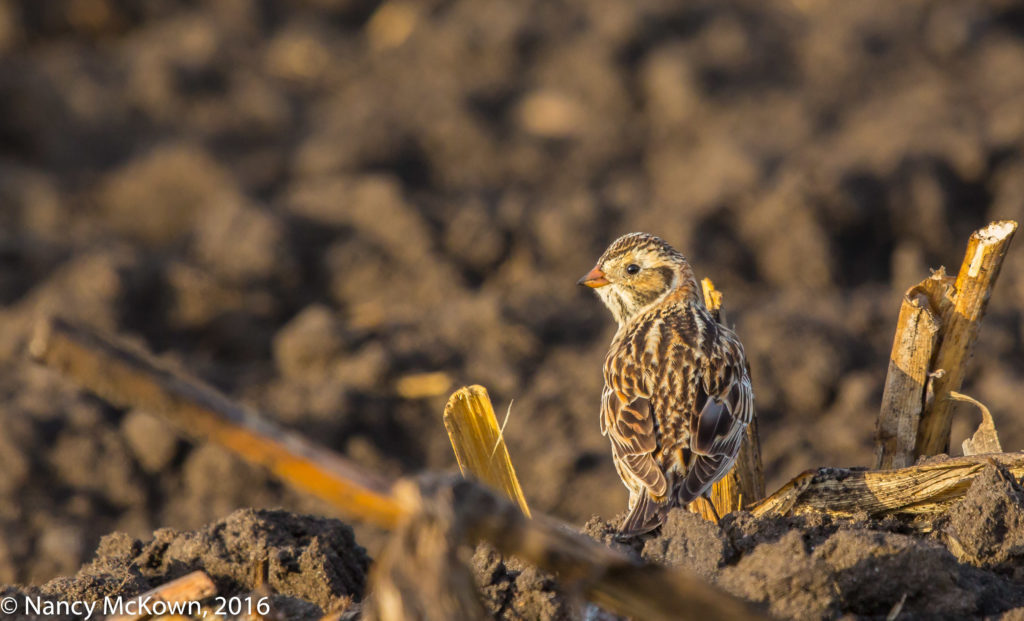Photographing the Lapland Longspur
The Lapland Longspur is an uncommon winter visitor in SW Michigan. Come Spring, this species migrates north to colder climates. Finding a Lapland Longspur in early summer, interspersed with other ground feeders like Horned Larks and Vesper Sparrows is a real treat. These rare sightings put me on high alert. I do NOT want to miss the shot.

Head and Neck Framed in the Center.
ISO2000; f/8; 1/640 Second
Luxury of Composition
I found this avian treasure late one morning while driving on a deserted county road in the Allegan State Game Area. He was foraging in a spent corn field near the edge of the road ideally close to the camera. Warm earth tone colors dominated the scene; consisting of mostly dark, plowed chunky earth in umber and ochre colors. A few dried golden stalks from last year’s corn lay in the field, reflecting the morning sunlight and complementing the bird’s plumage.
Before I brought the car to a full stop, I lifted the camera, 500mm lens and 1.4 tele extender from my lap and rested it on the bean bag cushion protecting the car door window. The Lapland Longspur noticed me immediately and stayed less than a minute, but it was enough time to get off a couple quick bursts.
That’s often the way it goes. The bird is long gone before I have a chance to think about the compositional options available to me.
Compositional Guides
I feel less pressure when an uncommon bird is unafraid and lingers within close view of the camera’s lens. I find myself taking more time to compose thoughtfully and precisely.
DSLR camera composing guidelines (available via the menu system) are customized to help the photographer visually arrange what she sees through the viewfinder. They serve as a starting point by overlaying a 9-part grid intended to help compose more artistically.
This framework allows you to mentally apply the “Rule of Thirds” by compartmentalizing the image into equal parts, horizontally and vertically. You then compose the scene by positioning the subject(s) in the frame in or around those intersecting lines, thus leading your viewer’s eyes to your subject(s).

Framed with Guidance from the Camera’s Viewfinder Grid.
ISO1250; f/8; 1/640 Second
Compositional Food for Thought
I find that applying the Rule of Thirds helps me pull together and balance elements when I’m composing — to accentuate the subject in a more pleasing and/or stimulating way. It also helps me visualize a square frame through the viewfinder, instead of the usual rectangular frame. (NOTE: To read more about image composition, press this link.)
Judicious cropping in post processing becomes easier when I pay attention to the rule of thirds while composing. So often my images have the bird positioned smack dab in the middle. That’s OK, but sometimes it’s compositionally prudent to shift your subject away from the middle point and accentuate other parts of the scene that may reveal a more complete story.
Of course, it helps when there is something captivating within the scene of my viewing screen to pull together.
Setting the Scene
Although I mentally apply the Rule of Thirds when photographing birds, I do not activate the viewfinder gridlines in my DSLR cameras because I find them distracting. I am more likely to use the grids when photographing people or places… where I have the time physically manipulate the camera and/or the subjects before I start shooting.
Being Prepared Only Goes So Far
Ultimately, being prepared only goes so far in bird photography. If I stumble upon unexpected bird activity, the primary objective is to deal with the limitations of light and location and capture the moment quickly. There’s rarely time to stop everything to indulge in the lavish luxury of setting the scene.
That said, I like to think that my quick GET THAT SHOT response to bird photography also includes a spark of compositional creativity. 😎

